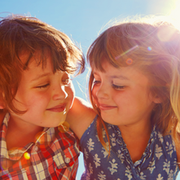Basic Emotions and How To Explain Them
- Autism Help UK

- Mar 15, 2021
- 5 min read
Updated: Mar 25, 2021
Autistic children can struggle with understanding emotions. That is why it is important for parents to teach emotions to their children. However, you might be stuck with this. So, here is a list of basic emotions to teach your child and how to explain them.

Basic Emotions
It is important to teach your child about basic emotions so they can recognise them in themselves and others. These include happiness, sadness, fear, anger, and disgust. These examples below will focus on ideas you can use for the following teaching tools:
Emotion Card Game- this is where you show a realistic picture and ask your child to identify the emotion that goes with it. Showing real pictures can help your child identify these emotions in real life situations.
Body Language Game- this is where you do a certain body position and see if your child can choose the right emotion for it.
Reading Tone Game- re-read the same sentence but using different tones each time and ask you child to guess which emotion you are using.
Observing & Telling- when you see your child using an emotion, let them know and explain why you can see they are using that emotion.
Happy

____________________
Being happy is usually shown with a big genuine smile on your face which lets others know you are in a good mood. This could be when you're enjoying life or when something good happens. Here are some ways you can explain this emotion to your child.
____________________
Card Game- Happy Images
Here are some situations where you may find happy people:
a party
family trip
wedding
playing with friends
Here are a few pictures you could use as inspiration:
Body Language Game- Happy Pose:
keep a smile on your face (with your eyes too!)
have a relaxed stance
be open- don't cross arms or legs
Reading Tone Game- Happy Tones:
upbeat tone
more high pitch
may be slightly louder than normal
Observing and Telling- Happy Situations:
When your child is happy, for example they are happy they are playing with their favourite toy, let them know and explain to them why they are happy. e.g. "you are happy right now because you are playing with your favourite toy. I can see your happy because you have a smile on your face."
Sad

____________________
Being sad is when you feel unhappy and sorrowful, which is usually shown with a frown on your face and possibly crying. This could be when you're get some bad news or your feelings have been hurt. Here are some ways you can explain this emotion to your child.
____________________
Card Game- Sad Images
Here are some situations where you may find sad people:
when you get hurt- e.g. scrapped knee
getting told off
when your friend leaves
Here are a few pictures you could use as inspiration:
Body Language Game- Sad Pose:
frown on face
droopy pose and looking down
tears
Reading Tone Game- Sad Tones:
quieter
lower pitch
flat tone throughout reading
may add in a few sniffles to appear as though they have been crying
short breaths- as if you are trying not to cry
Observing and Telling- Sad Situations:
When your child is sad, for example their best friend has gone home, let them know and explain to them why they are sad. e.g. "you are sad right now because you friend has left. I can see your sad because you have a frown on your face."
Anger

____________________
Being angry is when you feel frustrated about a situation which is usually shown with a frown on your face and scrunched eyebrows. This could be when you're in an argument or if you have been accused of something you haven't done. Here are some ways you can explain this emotion to your child.
____________________
Card Game- Angry Images
Here are some situations where you may find angry people:
a toy taken away
angry phone call
screaming
argument
Here are a few pictures you could use as inspiration:
Body Language Game- Angry Pose:
frown with scrunched eyebrows
flared nose
tense body posture with folded arms
clenched fists
Note: Let your child that when they are angry they may feel their face get warmer or go red and their chest may also feel tighter. They might also have the urge to hit someone but this is not the right response.
Reading Tone Game- Angry Tones:
low to very low pitch- deep voice
slightly loud to very loud (yelling)
added in noises e.g. ahhh and grrr to show your angry
Observing and Telling- Angry Situations:
When your child is angry, for example they are angry you have taken their toy off them, let them know and explain to them why they are angry. e.g. "you are angry right now because I have taken your toy from you. I can see your angry because you have a frown on your face, your eyebrows are scrunched up, and your arms are folded."
Fear

____________________
Fear is usually felt when you believe you are in danger or are experiencing something scary. When you feel fear you may feel more tense and your heart may beat faster and harder. The response to this emotion may be by running away from the threat or acting on our fear by fighting back (our fight or flight response). Here are some ways you can explain this emotion to your child.
____________________
Card Game- Images of Fear
Here are some situations where you may find people showing fear:
watching a scary movie
someone jumping out and scaring
tall rollercoaster
scaring someone with a spider or other scary thing
Here are a few pictures you could use as inspiration:
Body Language Game- Fear Pose:
open mouth and wide eyes
tense body pose
hands over mouth
little to no eye contact
hiding
Note: Let your child know that when they are scared they may feel their heart beat faster and they may breathe more.
Reading Tone Game- Fear Tones:
higher pitch
can be quite or loud
trembling voice
may say words wrong and repeat words- e.g. I-I-I'm not scared of y-y-you
Observing and Telling- Fear Situations:
When your child is fearful, for example they have done something naughty and they are scared, let them know and explain to them why they are fearful. e.g. "you are feeling fear right now because you know you have done something naughty and are scared of being told off. I can see your are feeling fear because you were hiding from me and your eyes are wide."
Disgust

____________________
Feeling disgust is when you are grossed out or disapproving of a situation. This is usually shown with a scrunched up face and sticking your tongue out. This could be when someone does something gross or you smell something horrible. Here are some ways you can explain this emotion to your child.
____________________
Card Game- Images of Disgust
Here are some situations where you may find people showing disgust:
eating something they don't like
watching something gross like a person eating insects
smelling something foul like dirty socks
Here are a few pictures you could use as inspiration:
Body Language Game- Disgust Pose:
scrunched nose, eyes squinting, scrunched eyebrows
mouth tightly closed or showing teeth or tongue out in disgust
arms out with palms up- as if saying stop with hands
Note: Let your child know that they may feel sick or have a queasy tummy when they feel disgusted.
Reading Tone Game- Disgust Tones:
mix of low tones- showing disapproval
and high tones- showing shock
add in extra words such as ewww, bluh, ugh.
Observing and Telling- Disgust Situations:
When your child is disgusted, for example they are disgusted by broccoli, let them know and explain to them why they are feeling disgusted. e.g. "you are disgusted right now because you don't like the taste of broccoli. I can see your disgusted because you your tongue is sticking out and your nose is scrunched."





















































Comments